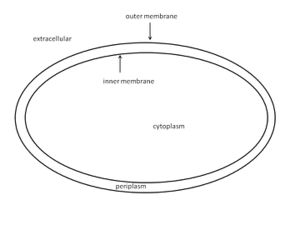User:GillenK: Difference between revisions
No edit summary |
No edit summary |
||
| Line 14: | Line 14: | ||
=Introduction= | =Introduction= | ||
< | < | ||
<i>Escherichia coli</i> (E. coli)is an inhabitant of the human intestine and a model organism for gram-negative bacteria (http://en.wikipedia.org/wiki/Escherichia_coli). While it has been long assumed that prokaryotes lack the sophistical intracellular architecture of eukaryotic cells and are unorganized bags of cytoplasm surrounded by a membrane, more recent research has shown that prokaryotes do indeed have | <i>Escherichia coli</i> (E. coli)is an inhabitant of the human intestine and a model organism for gram-negative bacteria (http://en.wikipedia.org/wiki/Escherichia_coli). While it has been long assumed that prokaryotes lack the sophistical intracellular architecture of eukaryotic cells and are unorganized bags of cytoplasm surrounded by a membrane, more recent research has shown that prokaryotes do indeed have cytoplasmic organization with the nucleoid and various proteins restricted to certain areas. A fundamental issue for cells is how to target protein to their correct cellular location. In gram-negative bacteria proteins may need to be selectively localized to the inner membrane, outer membrane, periplasm or secreted outside the cell (Figure 1). Proteins that fail to reach their correct localization will not function appropriately. | ||
[[Image:Hand_made_E._coli_compartments_schematic_take_two.jpg|thumb|25 × 25 px|right|A schematic diagram of compartments in E. coli. | [[Image:Hand_made_E._coli_compartments_schematic_take_two.jpg|thumb|25 × 25 px|right| Figure 1.A schematic diagram of compartments in E. coli.]] | ||
| Line 32: | Line 31: | ||
Introduce the topic of your paper. What microorganisms are of interest? Habitat? Applications for medicine and/or environment? | Introduce the topic of your paper. What microorganisms are of interest? Habitat? Applications for medicine and/or environment? | ||
=Inner Membrane= | |||
Include some current research, with at least one figure showing data. | Include some current research, with at least one figure showing data. | ||
=Periplasm= | |||
Include some current research, with at least one figure showing data. | Include some current research, with at least one figure showing data. | ||
=Outer membrane= | |||
Include some current research, with at least one figure showing data. | Include some current research, with at least one figure showing data. | ||
| Line 48: | Line 46: | ||
Overall text length at least 3,000 words, with at least 3 figures. | Overall text length at least 3,000 words, with at least 3 figures. | ||
References | =References= | ||
Cornelis, P. Current opinion in biotechnology 2000;11(5):450-4. http://www.sciencedirect.com/science?_ob=ArticleURL&_udi=B6VRV-41BV2FD-8&_user=7774802&_coverDate=10%2F01%2F2000&_rdoc=1&_fmt=high&_orig=gateway&_origin=gateway&_sort=d&_docanchor=&view=c&_searchStrId=1665295606&_rerunOrigin=google&_acct=C000062877&_version=1&_urlVersion=0&_userid=7774802&md5=1b0d9c4e9467114f398efccfe82636d5&searchtype=a | |||
Edited by student of Joan Slonczewski for BIOL 238 Microbiology, 2010, Kenyon College. | Edited by student of Joan Slonczewski for BIOL 238 Microbiology, 2010, Kenyon College. | ||
Retrieved from "http://microbewiki.kenyon.edu/index.php/BIOL_238_Paper_2010" | Retrieved from "http://microbewiki.kenyon.edu/index.php/BIOL_238_Paper_2010" | ||
Category: Pages edited by students of Joan Slonczewski at Kenyon College | Category: Pages edited by students of Joan Slonczewski at Kenyon College | ||
Revision as of 03:19, 5 March 2011
Targeting of proteins to different cellular compartments in E. coli. From MicrobeWiki, the student-edited microbiology resource Jump to: navigation, search Contents [hide]
* 1 Introduction * 2 Section 1 * 3 Section 2 * 4 Section 3 * 5 Conclusion * 6 References
Introduction
<
Escherichia coli (E. coli)is an inhabitant of the human intestine and a model organism for gram-negative bacteria (http://en.wikipedia.org/wiki/Escherichia_coli). While it has been long assumed that prokaryotes lack the sophistical intracellular architecture of eukaryotic cells and are unorganized bags of cytoplasm surrounded by a membrane, more recent research has shown that prokaryotes do indeed have cytoplasmic organization with the nucleoid and various proteins restricted to certain areas. A fundamental issue for cells is how to target protein to their correct cellular location. In gram-negative bacteria proteins may need to be selectively localized to the inner membrane, outer membrane, periplasm or secreted outside the cell (Figure 1). Proteins that fail to reach their correct localization will not function appropriately.
File:EscherichiaColi NIAID.jpg
[x 400px|right|A schematic diagram of compartments in E. coli. From Current Opinion in Biotechnology, ] Other examples: Bold Italic Subscript: H2O Superscript: Fe3+
Introduce the topic of your paper. What microorganisms are of interest? Habitat? Applications for medicine and/or environment?
Inner Membrane
Include some current research, with at least one figure showing data.
Periplasm
Include some current research, with at least one figure showing data.
Outer membrane
Include some current research, with at least one figure showing data. Conclusion
Overall text length at least 3,000 words, with at least 3 figures.
References
Cornelis, P. Current opinion in biotechnology 2000;11(5):450-4. http://www.sciencedirect.com/science?_ob=ArticleURL&_udi=B6VRV-41BV2FD-8&_user=7774802&_coverDate=10%2F01%2F2000&_rdoc=1&_fmt=high&_orig=gateway&_origin=gateway&_sort=d&_docanchor=&view=c&_searchStrId=1665295606&_rerunOrigin=google&_acct=C000062877&_version=1&_urlVersion=0&_userid=7774802&md5=1b0d9c4e9467114f398efccfe82636d5&searchtype=a
Edited by student of Joan Slonczewski for BIOL 238 Microbiology, 2010, Kenyon College. Retrieved from "http://microbewiki.kenyon.edu/index.php/BIOL_238_Paper_2010" Category: Pages edited by students of Joan Slonczewski at Kenyon College

